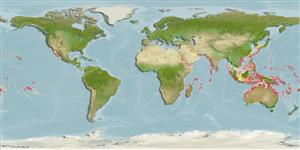>
Gobiiformes (Gobies) >
Gobiidae (Gobies) > Gobiinae
Etymology: Eviota: No etymology given, suggested by Christopher Scharpt: from Latin 'eu' for 'true' and 'iota' for anything very small, in combination 'truly very small' referring to it as being the smallest vertebrate at the time it has benn described by Jenkins (thus, making the suggestion by Scharpt plausible..
More on authors: Lachner & Karnella.
Environment: milieu / climate zone / depth range / distribution range
Écologie
marin; saumâtre récifal. Tropical
Indian Ocean.
Taille / Poids / Âge
Maturity: Lm ? range ? - ? cm
Max length : 1.9 cm SL mâle / non sexé; (Ref. 116739)
Inhabits dead algal-covered reef in 3-15 m (Ref. 90102). Reported to feed primarily on harpacticoid copepods (49.5% - 100% of the gut contents) and they consume an average of 249 copepods per square meter of reef surface (Ref. 116739).
Life cycle and mating behavior
Maturities | Reproduction | Spawnings | Egg(s) | Fecundities | Larves
Tornabene, L., D.W. Greenfield and M.V. Erdmann, 2021. A review of the Eviota zebrina complex, with descriptions of four new species (Teleostei, Gobiidae). ZooKeys 1057:149-184. (Ref. 126577)
Statut dans la liste rouge de l'IUCN (Ref. 130435)
Menace pour l'homme
Harmless
Utilisations par l'homme
Outils
Articles particuliers
Télécharger en XML
Sources Internet
Estimates based on models
Preferred temperature (Ref.
123201): 24.4 - 29.3, mean 28.3 °C (based on 2876 cells).
Phylogenetic diversity index (Ref.
82804): PD
50 = 0.5000 [Uniqueness, from 0.5 = low to 2.0 = high].
Bayesian length-weight: a=0.00708 (0.00333 - 0.01504), b=3.09 (2.92 - 3.26), in cm total length, based on LWR estimates for this (Sub)family-body shape (Ref.
93245).
Niveau trophique (Ref.
69278): 3.0 ±0.3 se; based on size and trophs of closest relatives
Résilience (Ref.
120179): Haut, temps minimum de doublement de population inférieur à 15 mois (Preliminary K or Fecundity.).
Fishing Vulnerability (Ref.
59153): Low vulnerability (10 of 100).
Nutrients (Ref.
124155): Calcium = 404 [167, 1,168] mg/100g; Iron = 1.54 [0.66, 3.46] mg/100g; Protein = 17.6 [15.5, 19.4] %; Omega3 = 0.106 [0.036, 0.297] g/100g; Selenium = 33.2 [9.7, 98.3] μg/100g; VitaminA = 123 [24, 593] μg/100g; Zinc = 4.31 [2.36, 7.23] mg/100g (wet weight);
